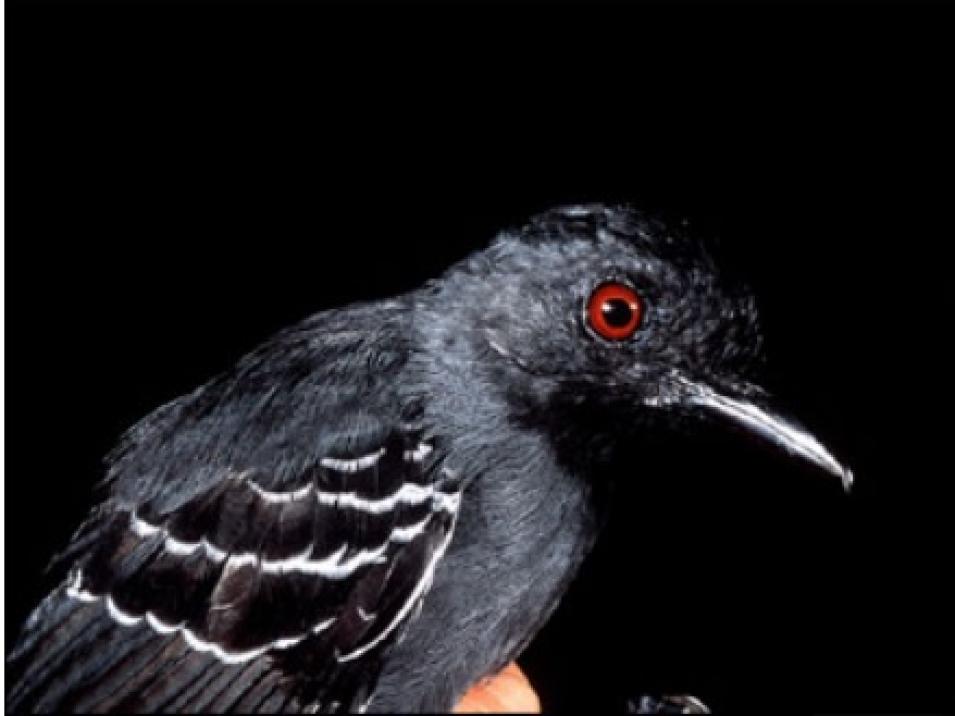Besides impacting tree populations, fragmentation alters habitat vital to rainforest animals, particularly in the forest understory — the small trees and vines between the forest floor and the upper canopy. Protected from wind and rain, the shaded understory provides a dark, cool, humid environment for a variety of specialized mammals, birds, frogs, and insects. "A lot of the understory birds are sensitive to fragmentation. They're adapted to deep, dark forest conditions, and they won't come out anywhere near a road or clearing," said Laurance.
Because the rainforest ecosystem supports complex webs of interactions, when extinction claims one animal, plant, or insect, other creatures suffer as well. For instance, explained Laurance, a number of frog species use the little wallow ponds made by peccaries (wild pigs). The peccaries need large areas for foraging, so when fragmentation reduces their range and drives them out of the ecosystem, frogs in the area start disappearing.
Fragmented forests also isolate animal populations, which can be a driving force behind extinction. Animals such as jaguars and pumas require large areas, and fragmentation can limit their ability to hunt or force them deeper into the forest. In addition, fragmentation increases human access to the forests, attracting hunters who kill jaguars, monkeys, deer, and agoutis (giant rodents), Laurance said.
Laurance cited road building as one of the main culprits behind forest loss and fragmentation. The Brazilian government currently plans to pave about 7,500 kilometers (about 4,600 miles) of new highways that will provide more access to the Amazon interior, and Laurance's research indicates that this will increase fragmentation of the rainforest.
Fragmentation begins when a paved highway penetrates undisturbed forest. Loggers and colonists then build numerous roads branching off of the highway, creating a pattern of land use that fragments long strips of forest. "Once you get a major highway providing year-round access, then all kinds of things happen — colonization, logging, and a lot more road development," Laurance said. And once the colonists reach their pristine destination, fire-based agriculture then poses a problem for the Amazon's remaining forests. Colonists hoping to tame a piece of the rainforest often clear the land for agriculture with slash-and-burn techniques.
Laurance also blames "surface fires," annual fires that farmers light in their pastures to destroy weeds and produce fresh grass. These fires burn not only the pastures, but often spread into the surrounding forest as well.
"Because fire is foreign to the rainforest ecosystem, the plants there are just not adapted to it. Even a little fire that's only 10 or 20 centimeters (4 to 8 inches) high will slowly burn through the forest understory, killing 20 to 50 percent of the trees and all of the vines," said Laurance. Dead trees and vines then accumulate on the forest floor, becoming tinder that fuels the following year's fire."Every time there's a new fire, it creates more flammable material. So at the end of the cycle there is just a scorched landscape of completely destroyed forest," Laurance said. "You can literally see the fragments imploding over time." The problem worsens when El Niño years bring drought to the region, making the forests even more vulnerable to fire.
Data from Laurance's study, along with a variety of other data sets generated by the LBA project, will be archived and available from the LBA web site in Brazil and NASA's Oak Ridge National Laboratory (ORNL) Distributed Active Archive Center (DAAC). As scientists gather more data, they will gain a clearer understanding of how land use change affects the Amazon and its ability to store carbon.
Laurance hopes that his research will ultimately promote policy change. The Brazilian government is trying to develop sustainable economic strategies for the rainforest, but land in the rainforest is so cheap that once a farmer's soil is depleted, he can simply purchase another patch of forest to clear and burn. "Rather than relying on very destructive fire-based agriculture," Laurance said, "we're advocating a system in which there are more incentives for farmers to invest in their land and develop more sustainable kinds of agricultural strategies." By making currently cleared land more productive, he suggests, farmers could work closer to existing markets, and the government could then set aside larger tracts of pristine rainforest, preserving the rich flora and fauna of the Amazon.
References
Pimm, Stuart L. 1998. The forest fragment classic. Nature 393: 23-24.
Laurance, W.F., P. Delamônica, S.G. Laurance, H.L. Vasconcelos, and T.E. Lovejoy. 2000. Rainforest fragmentation kills big trees. Nature 404: 836.
Laurance, W.F., S.G. Laurance, L.V. Ferreira, J.M. Rankin-de Merona, C. Gascon, and T.E. Lovejoy. 1997. Biomass collapse in Amazonian forest fragments. Science 278:117-118.
Laurance, W.F., M.A. Cochrane, S. Bergen, P.M. Fearnside, P. Delômonica, C. Barber, S. D'Angelo, and T. Fernandes. 2001. The future of the Brazilian Amazon. Science 291(5503): 438-439.
For more information
NASA Oak Ridge National Laboratory Distributed Active Archive Center (ORNL DAAC)
Large Scale Biosphere-Atmosphere Experiment in Amazonia
Large Scale Biosphere-Atmosphere Experiment in Amazonia ECO project
An Introduction to the Large Scale Biosphere-Atmosphere Experiment in Amazonia
Smithsonian Tropical Research Institute
Stealing Rain from the Rainforest
From Forest to FIeld
The Road to Recovery
| About the data used |
| Data |
Forest fragment grids |
| Parameter |
Effects of land use changes |
| DAAC |
NASA Oak Ridge National Laboratory Distributed Active Archive Center (ORNL DAAC) |


